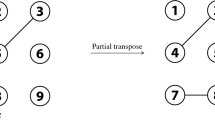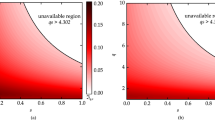Abstract
The k-ME concurrence as a measure of multipartite entanglement (ME) unambiguously detects all k-nonseparable states in arbitrary dimensions and satisfies many important properties of an entanglement measure. Negativity is a simple computable bipartite entanglement measure. Invariant and tangle are useful tools to study the properties of the quantum states. In this paper, we mainly investigate the internal relations among the k-ME concurrence, negativity, polynomial invariants, and tangle. Strong links between k-ME concurrence and negativity as well as between k-ME concurrence and polynomial invariants are derived. We obtain the quantitative relation between k-ME \((k=n)\) concurrence and negativity for all n-qubit states, give an exact value of the n-ME concurrence for the mixture of n-qubit GHZ states and white noise, and derive an connection between k-ME concurrence and tangle for n-qubit W state. Moreover, we find that for any 3-qubit pure state the k-ME concurrence \((k=2, 3)\) is related to negativity, tangle, and polynomial invariants, while for 4-qubit states the relations between k-ME concurrence (for \(k = 2, 4)\) and negativity, and between k-ME concurrence and polynomial invariants also exist. Our work provides clear quantitative connections between k-ME concurrence and negativity, and between k-ME concurrence and polynomial invariants.
Similar content being viewed by others
References
Horodecki, R., et al.: Quantum entanglement. Rev. Mod. Phys. 81, 865 (2009)
Ekert, A.K.: Quantum cryptography based on Bell’s theorem. Phys. Rev. Lett. 67, 661 (1991)
Bennett, C.H., et al.: Teleporting an unknown quantum state via dual classical and Einstein–Podolsky–Rosen channels. Phys. Rev. Lett. 70, 1895 (1993)
Gao, T., Yan, F.L., Li, Y.C.: Optimal controlled teleportation. Europhys. Lett. 84, 50001 (2008)
Bennett, C.H., Wiesner, S.J.: Communication via one- and two-particle operators on Einstein–Podolsky–Rosen states. Phys. Rev. Lett. 69, 2881 (1992)
Gross, C., et al.: Nonlinear atom interferometer surpasses classical precision limit. Nature 464, 1165 (2010)
Eltschka, C., Siewert, J.: Quantifying entanglement resources. J. Phys. A Math. Theor. 47, 424005 (2014)
Bennett, C.H., et al.: Mixed-state entanglement and quantum error correction. Phys. Rev. A 54, 3824 (1996)
Hill, S., Wootters, W.K.: Entanglement of a pair of quantum bits. Phys. Rev. Lett. 78, 5022 (1997)
Wootters, W.K.: Entanglement of formation of an arbitrary state of two qubits. Phys. Rev. Lett. 80, 2245 (1998)
Rungta, P., et al.: Universal state inversion and concurrence in arbitrary dimensions. Phys. Rev. A 64, 042315 (2001)
Carvalho, A.R.R., Mintert, F., Buchleitner, A.: Decoherence and multipartite entanglement. Phys. Rev. Lett. 93, 230501 (2004)
Hong, Y., Gao, T., Yan, F.L.: Measure of multipartite entanglement with computable lower bounds. Phys. Rev. A 86, 062323 (2012)
Gao, T., Hong, Y.: Detection of genuinely entangled and nonseparable \(n\)-partite quantum states. Phys. Rev. A 82, 062113 (2010)
Gao, T., et al.: Efficient \(k\)-separability criteria for mixed multipartite quantum states. Europhys. Lett. 104, 20007 (2013)
Gao, T., Yan, F.L., van Enk, S.J.: Permutationally invariant part of a density matrix and nonseparability of \(N\)-qubit states. Phys. Rev. Lett. 112, 180501 (2014)
Vidal, G., Werner, R.F.: Computable measure of entanglement. Phys. Rev. A 65, 032314 (2002)
Dür, W., et al.: Distillability and partial transposition in bipartite systems. Phys. Rev. A 61, 062313 (2000)
Horodecki, M., Horodecki, P., Horodecki, R.: Mixed-state entanglement and distillation: is there a “bound” entanglement in nature? Phys. Rev. Lett. 80, 5239 (1998)
Lee, S., et al.: Convex-roof extended negativity as an entanglement measure for bipartite quantum systems. Phys. Rev. A 68, 062304 (2003)
Vidal, G.: Entanglement monotones. J. Mod. Opt. 47, 355 (2000)
Sharma, S.S., Sharma, N.K.: Quantum coherences, \(K\)-way negativities and multipartite entanglement. Phys. Rev. A 77, 042117 (2008)
Dür, W., Vidal, G., Cirac, J.I.: Three qubits can be entangled in two inequivalent ways. Phys. Rev. A 62, 062314 (2000)
Kraus, B.: Local unitary equivalence and entanglement of multipartite pure states. Phys. Rev. A 82, 032121 (2010)
Liu, B., et al.: Local unitary classification of arbitrary dimensional multipartite pure states. Phys. Rev. Lett. 108, 050501 (2012)
Wang, S.H., Lu, Y., Long, G.L.: Entanglement classification of \(2\times 2 \times 2 \times d\) quantum systems via the ranks of the multiple coefficient matrices. Phys. Rev. A 87, 062305 (2013)
Li, X.R., Li, D.F.: Polynomial invariants of degree \(4\) for even-\(n\) qubits and their applications in entanglement classification. Phys. Rev. A 88, 022306 (2013)
Sanz, M., et al.: Entanglement classification with algebraic geometry. J. Phys. A Math. Theor. 50, 195303 (2017)
Grassl, M., Rötteler, M., Beth, T.: Computing local invariants of quantum-bit systems. Phys. Rev. A 58, 1833 (1998)
Linden, N., et al.: On multi-particle entanglement. Fortsch. Phys. 46, 567 (1998)
Meyer, D.A., Wallach, N.R.: Global entanglement in multiparticle systems. J. Math. Phys. 43, 4273 (2002)
Choi, J.H., Kim, J.S.: Negativity and strong monogamy of multiparty quantum entanglement beyond qubits. Phys. Rev. A 92, 042307 (2015)
Coffman, V., Kundu, J., Wootters, W.K.: Distributed entanglement. Phys. Rev. A 61, 052306 (2000)
Nielsen, M.A., Chuang, I.L.: Quantum Computation and Quantum Information. Cambridge University Press, Cambridge (2010)
Dür, W., Cirac, J.I.: Classification of multiqubit mixed states: separability and distillability properties. Phys. Rev. A 61, 042314 (2000)
Gao, T., Hong, Y.: Separability criteria for several classes of \(n\)-partite quantum states. Eur. Phys. J. D 61, 765 (2011)
Sudbery, A.: On local invariants of pure three-qubit states. J. Phys. A Math. Gen. 34, 643 (2001)
Barnum, H., Linden, N.: Monotones and invariants for multi-particle quantum states. J. Phys. A Math. Gen. 34, 6787 (2001)
Verstraete, F., et al.: Four qubits can be entangled in nine different ways. Phys. Rev. A 65, 052112 (2002)
Gorbachev, V.N., et al.: Can the states of the W-class be suitable for teleportation? Phys. Lett. A 314, 267 (2003)
Joo, J., et al.: Quantum teleportation via a W state. New J. Phys. 5, 136 (2003)
Joo, J., et al.: Quantum secure communication with W states. arXiv:quant-ph/0204003
Cabello, A.: Bell’s theorem with and without inequalities for the three-qubit Greenberger–Horne–Zeilinger and W states. Phys. Rev. A 65, 032108 (2002)
Acknowledgements
This work was supported by the National Natural Science Foundation of China under Grant No. 11475054 and the Hebei Natural Science Foundation under Grant Nos. A2016205145 and A2018205125.
Author information
Authors and Affiliations
Corresponding author
Additional information
Publisher's Note
Springer Nature remains neutral with regard to jurisdictional claims in published maps and institutional affiliations.
Rights and permissions
About this article
Cite this article
Zhang, L., Gao, T. & Yan, F. Relations among k-ME concurrence, negativity, polynomial invariants, and tangle. Quantum Inf Process 18, 194 (2019). https://doi.org/10.1007/s11128-019-2223-8
Received:
Accepted:
Published:
DOI: https://doi.org/10.1007/s11128-019-2223-8




